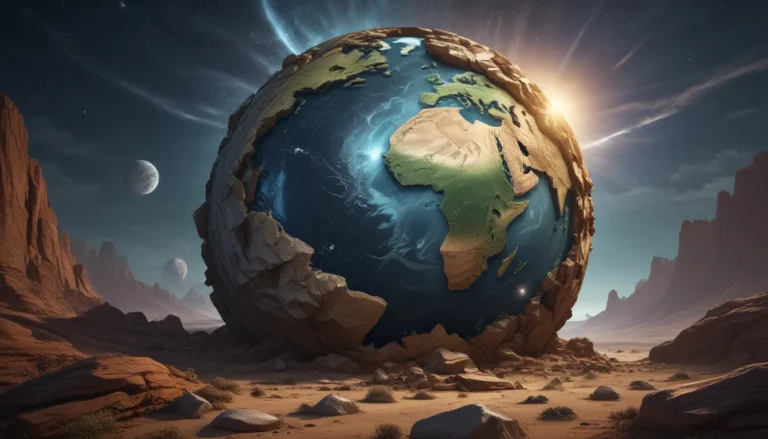A Note About Images: The images used in our articles are for illustration purposes only and may not exactly match the content. They are meant to engage readers, but the text should be relied upon for accurate information.
Welcome to a captivating journey through the geosphere, a fundamental part of the Earth’s interconnected systems that holds a myriad of wonders waiting to be discovered. From the majestic mountains to the depths of the ocean floor, the geosphere showcases the dynamic forces shaping our planet. In this article, we will delve into 10 fascinating geosphere fun facts that shed light on Earth’s geological marvels. Join us as we unravel the mysteries of the geosphere and gain a deeper appreciation for the awe-inspiring forces at play beneath our feet.
The Earth’s Geosphere: A World of Rocks, Minerals, and Landforms
The geosphere forms the solid part of the Earth, encompassing rocks, minerals, and landforms that make up the planet’s surface. From towering mountains to vast plains, the geosphere plays a vital role in shaping Earth’s landscape and providing essential resources for life to thrive.
Delving Into the Layers of the Geosphere
The Earth’s geosphere is divided into three main layers: the crust, mantle, and core. The crust, the outermost layer, consists of continental and oceanic crust. Beneath the crust lies the mantle, composed of solid rock that can flow over long periods. At the center of the Earth resides the core, comprising the outer core and inner core primarily made of iron and nickel.
Constant Change in the Geosphere
The geosphere is in a perpetual state of change due to processes like erosion, weathering, and tectonic plate movement. Erosion and weathering wear down rocks and landforms over time, shaping the Earth’s surface. Tectonic plate movement leads to earthquakes, volcanic eruptions, and the formation of mountain ranges, contributing to the dynamic nature of the geosphere.
Valuable Resources Hiding in the Geosphere
The Earth’s geosphere is a rich source of valuable resources, including minerals, metals, and fossil fuels. These resources play a crucial role in various human activities, from construction and manufacturing to energy production. The diverse materials found in the geosphere have been essential in the development of human civilization and continue to support modern industry.
Understanding Earth’s Past and Predicting the Future
Studying the geosphere provides insights into Earth’s geological history and helps in predicting future changes. By analyzing rock formations, fossils, and landforms, scientists can uncover information about past environmental conditions and the evolution of life on Earth. Understanding the geosphere is crucial for assessing natural hazards and mitigating potential risks.
Interconnected Spheres: The Geosphere’s Relationship with Other Earth Systems
The geosphere interacts closely with the atmosphere, hydrosphere, and biosphere, influencing natural processes like the water cycle, nutrient cycling, and soil formation. Understanding these interconnected systems is essential for addressing environmental challenges and sustaining the planet’s ecosystems.
Diverse Landforms of the Geosphere
The geosphere boasts a wide range of captivating landforms, including mountains, valleys, deserts, and canyons, each with its unique characteristics and geological history. These landforms are a result of intricate geological processes that have unfolded over millions of years, showcasing the remarkable diversity of the Earth’s surface.
Impact on Climate and Weather Patterns
The geosphere plays a pivotal role in shaping Earth’s climate and influencing global weather patterns. Features such as mountains, oceans, and landmasses impact the distribution of heat and moisture across the planet, contributing to regional climates and weather phenomena. Understanding the geosphere’s influence on climate is crucial for predicting changes and addressing climate-related challenges.
Human Impact on the Geosphere
Human activities, such as mining, deforestation, and urbanization, have significant effects on the geosphere. These activities can result in habitat destruction, soil degradation, and the depletion of natural resources. Understanding the consequences of human impact on the geosphere is imperative for promoting sustainable practices and minimizing environmental damage.
Unveiling Clues to Earth’s Past
The geosphere holds valuable clues to Earth’s history, providing a foundation for scientific exploration and discovery. By delving into the geosphere, researchers can unravel the mysteries of the Earth’s evolution, gaining insights into the forces that have shaped its landscapes over time.
Conclusion: Exploring the Geosphere’s Marvels
The geosphere is a dynamic and fascinating component of our planet that shapes Earth’s landscapes and sustains life. Delving into the geosphere not only enriches our understanding of the planet but also offers valuable insights for addressing environmental challenges and natural resource management. By exploring the wonders of the geosphere, we gain a deeper appreciation for the geological forces that have shaped our planet for millions of years.
FAQs
What are the main components of the geosphere?
The geosphere comprises the lithosphere, which includes the Earth’s crust and upper mantle, as well as the asthenosphere and mesosphere, forming the solid Earth and governing geological processes.
How does the geosphere impact the environment?
The geosphere influences the environment through processes such as rock weathering, soil formation, and the release of minerals and nutrients, with far-reaching effects on ecosystems, agriculture, and overall planetary health.
Your Feedback Matters
Our commitment to providing accurate and engaging content is at the core of what we do. Every fact on our site is contributed by real users like you, bringing a wealth of diverse insights and information. Trust in our dedication to quality and authenticity as you explore and learn with us.






